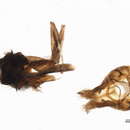Comprehensive Description
provided by Smithsonian Contributions to Zoology
Leucotrichia fairchildi Flint
Leucotrichia fairchildi Flint, 1970:10.
Known previously only from Panama, this record from Venezuela represents a significant extension of range. Taken together with the one mature male pupa were a number of larvae and immature pupae. They may well be the same species, or possibly, in part, those of the preceeding species.
MATERIAL.—VENEZUELA, ARAGUA: Estacion Piscicultura, 16 Feb 1976, 1 pupa.
This is a genus of only 6 species (Flint, 1970), previously known only from Central America. Because they are rarely taken, it is difficult to predict if more species may be found in Venezuela.
The immature stages are unknown, but will probably have the same general appearance and habits as Leucotrichia or Zumatrichia.
- bibliographic citation
- Flint, Oliver S., Jr. 1981. "Studies of Neotropical Caddisflies, XXVIII: The Trichoptera of the RA-o Limón Basin, Venezuela." Smithsonian Contributions to Zoology. 1-61. https://doi.org/10.5479/si.00810282.330
Comprehensive Description
provided by Smithsonian Contributions to Zoology
Leucotrichia fairchildi Flint
Leucotrichia fairchildi Flint, 1970:10–11; 1981a:25.
The species is known from northern Panama and northern Venezuela, and now from northern Colombia.
MATERIAL.—COLOMBIA. DPTO. ANTIOQUIA: Quebrada La Jiménez, Sopetrán (trap C), May-Sep 1983, U. Matthias, 15 25. DPTO. TOLIMA: Armero, near Guayabal, 2–10 Feb 1977, E.L. Peyton, malaise trap, 3, 2.
- bibliographic citation
- Flint, Oliver S., Jr. 1991. "Studies of Neotropical Caddisflies, XLV: The Taxonomy, Phenology, and Faunistics of the Trichoptera of Antioquia, Colombia." Smithsonian Contributions to Zoology. 1-113. https://doi.org/10.5479/si.00810282.520
Comprehensive Description
provided by Smithsonian Contributions to Zoology
Leucotrichia fairchildi
This species shares with pictipes the distinction of having extreme modifications of the head and antennae. From pictipes, fairchildi differs in the type of modifications of the head, in the broader basal antennal segments, in the possession of an apicomesal point on the seventh sternum, and in many particulars in the male genitalia. From sarita, from which I find no differences in the male genitalia, fairchildi differs totally in the structure of the head, antennae, and seventh sternum.
ADULT.—Length of forewing, 2.5 mm. Color fuscus with green linear marks on forewing, and tegulae; antenna with alternating series of light and dark segments. Ocelli 2; posterolateral wart large, with setiferous, membranous lobe protruding from beneath, with a pair of anterolateral pouches bearing specialized setae, anteromesally with a membranous, setiferous “tentacle”; antenna with basal segment slightly enlarged, basal flagellar segments very broad and thin, forming a concave cup, apical segments elongate and cylindrical. Male genitalia: Seventh sternum with a small apicomesal point. I am unable to find any other differences in the genitalia between this species and those of sarita, for which see drawings and descriptions.
MATERIAL.—Holotype, male. PANAMA: COCLE: El Valle, 17 Dec. 1929, G. Fairchild, MCZ collection.
Costatrichia Mosely, 1937, p. 166. [Type species: Costatrichia lodora Mosely, 1937, by original designation.]
ADULT.—Ocelli 3. Spurs 1, 3, 4. Pronotum slightly elongate. Antenna with basal segment simple, sometimes with segments at midlength expanded. Mesoscutellum with transverse suture; metascutellum nearly triangular. Forewing often with reflexed costal cell. Male genitalia: Seventh sternum with an apicomesal pointed process. Eighth sternum produced posteroventrally, sometimes bearing processes. Ninth segment completely open ventrally, with a setose posterolateral process. Tenth tergite (?) heavily sclerotized, often united to ninth segment, forming a strong lateral brace to aedeagus. Lateral penis sheath generally large and ovoid, sometimes small and indistinct. Clasper elongate, generally divided into dorsal and ventral branches, not fused to each other mesally. Aedeagus with a basal tubular section passing into a midlength complex which bears circular “windows” in lateral aspect and a large basal loop, apex with a membranous central tube with various combinations of spines and lateral plates.
LARVA.—Unknown.
Costatrichia, as here used, is not as tightly knit a group as are either Leucotrichia or Zumatrichia. It is clearly related to these genera, however, as is shown by the general structure of the aedeagus. Although in the form of the genitalia, Costatrichia approaches Zumatrichia most closely, it is easily separated from this genus by having three ocelli and unmodified basal antennal segments.
Costatrichia simplex, new species, and C. spinifera, new species, are clearly very closely related, and may be considered to form the simplex group. They are characterized by unmodified antennae and lack of a reflexed costal cell on the forewing together with a very similar form of the genitalia. The remaining species, lodora Mosely, panamensis Flint, tripartita, new species, and bipartita, new species, may be considered to form the second group, the lodora group. In these species some of the antennal segments are greatly broadened and the forewings possess a reflexed costal cell. In these species there is more variation in the form of the genitalia, although all possess more or less strongly divided claspers.
The immature stages of this genus are totally unknown. However, based on adult affinities, I would expect the larvae to have enlarged abdominal segments five to seven.
- bibliographic citation
- Flint, Oliver S., Jr. 1970. "Studies of Neotropical Caddisflies X: Leucotrichia and Related Genera from North and Central America (Trichoptera: Hydroptilidae)." Smithsonian Contributions to Zoology. 1-64. https://doi.org/10.5479/si.00810282.60

